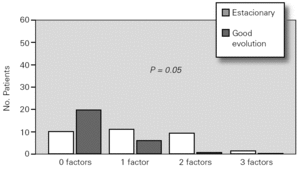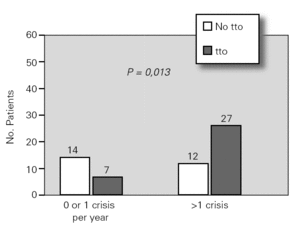INTRODUCTION
Prevalence of asthma is increasing in industrialized countries in the last few decades and it is a significant cause of morbidity. In Spain the prevalence varies between 6-12 %.1,2 Most of the cases of asthma begin during the first years of life, but not every infant and small child who wheezes in the first few years of life will go on to develop asthma.3-5
The wheezy infant is defined as a child that has had at least three lower respiratory tract illnesses with wheezing in the first two years of life and the first episode before the age of one. The factors determining the different outcomes are only partially known but the main factor associated with the persistence of asthma seems to be allergy.1,3
Transient early wheezing in non-atopic babies is related to common viral infections such as respiratory syncytial virus and, with a lower frequency, adenovirus and parainfluenza.2,3,6 But it is difficult to distinguish between these children with transient early wheeze and those who will progress to persistent disease.
The aim of this study is: a) to determine high risk factors of developing asthma in a group of patients with recurrent wheezing during the first three years of life. b) to compare differences in the evolution and severity of exacerbations in atopic and non atopic children and the response to treatment in both groups.
MATERIAL AND METHODS
It is a prospective study of 60 patients with frequent wheezing episodes, controlled in our Section, during a 6 months period (December 2003-May 2004).
Inclusion criteria: male and female patients aged # 3 years, that have had at least three lower respiratory tract illnesses with wheezing in the first two years of life. All had the first episode before the age of one.
Exclusion criteria: patients were ineligible for the study if they showed: gestational age below 37 weeks, immunodeficiency, congenital heart disease, cystic fibrosis, gastroesophageal reflux or anatomic abnormalities of the respiratory tract.
The following variables were collected:
a)Age at the first visit and age of starting wheezing; vaccinations; allergy history of atopic dermatitis, food allergies or urticaria and parental history of asthma, allergic rhinitis or atopic eczema.
b)Clinical manifestations such as frequency of wheezing (number of exacerbations per year) and severity of the episodes (number of emergency department visits and hospitalisations) were collected. The clinical evolution during the last year was also analysed.
c)Environmental factors as exposure to inhaled allergens or tobacco smoke, association with viral respiratory illnesses and assistance to a daycare center were questioned.
An accurate physical examination was performed, including: physical development, evaluation of the skin, examination of the conjunctiva and the nose, otoscopic examination of the ear and chest examination.
All patients underwent the following determinations:
• Complete blood count: eosinophilia was defined as more than 500 eosinophils/μl of blood.
• Serum IgE levels (measured in international units per mililiter). Values greater than + 2 DS over the mean were considered positive.
• Allergen-specific IgE determination by enzyme immune analysis CAP System (Pharmacía, Uppsala, Sweeden).Values equal or greater than 0,35 kU/l were considered positive.
• Skin-test reactivity to allergens performed by the prick technique. The extracts used were the common aeroallergens in Catalonia area. Histamine dihydrochloride (10 mg/ml) and saline solution (NaCl at 0,9 %) were used as positive and negative controls, respectively. Papules greater than 3 mm compared with the negative control were considered positive. None of the patients were receiving drugs which could affect the result of the test.
• Chest and cavum radiographs.
• Immunoreactive trypsinogen. This determination is included in the newborn screening since 1999 in Catalonia area (Spain).
Treatment of wheezing exacerbations (with adrenergic agents and/or glucocorticoids) and long-term-control medications (inhaled glucocorticoids and/or leukotriene-modifying agents) were asked in the first visit.
Statistical Analysis
The SPSS 10.0 program was used for the statistical analysis of the results. Comparison of means was done by the Student's t test for variables with normal distribution or the Mann-Whitney test for variables with no normal distribution.
Chi-square test was used for the categorical variables (or the Fisher's exact test, if applicability conditions were not fulfilled).
Statistical significance was defined by a two-sided alpha level of 0,05.
RESULTS
Sixty patients were included in the study: 39 (65 %) were boys and 21 (35 %) girls. The mean age of starting wheezing was 8,92 months (SD: 10,19) and the mean age at first visit in our Hospital was 26,22 months (SD: 10,19). 33 patients had a familial history of allergy (55 %) and 38 personal history of atopy (63 %). Of the sixty patients 13 (21,67 %) had atopic eczema, 17 (28,33 %) food allergy and 8 (13,33 %) both pathologies.
Most of the children (46 = 76,6 %) wheeze in relation with colds and during winter period 40 (68,33 %). Only 6 (10 %) had exacerbations in association with inhaled allergen exposure. Half of the children (30) assist to a daycare center (fig. 1).
Figure 1.-- Environmental factors wheezing exacerbations.
The group of children with personal history of atopic eczema, food allergy and/or familial history of atopy, have had more exacerbations during the last year. We observed that the proportion of patients that had more than one exacerbation last year increases if the number of risk factors does (p = 0,05) (fig. 2).
Figure 2.--Risk factors of asthma vs. number exacerbations last year. Risk factors: food allergy, atopic ezcema, familial history of atopy.
The concomitant existence of other factors such us: eosinophilia, high IgE levels and skin-tests positivity to aeroallergens is associated with poor evolution during this period of time (p = 0,05) (fig. 3).
Figure 3.--Risk factors of asthma vs. evolution last year. Risk factors: high IgE levels, eosinophilia, skin test positivity.
The patients with favourable outcome were the group that wheeze in relation with viral respiratory illnesses during winter months (p = 0,008).
Thirty four (56 %) of patients received continuous treatment to controlled wheezing exacerbations. This group of children have had poor evolution during last year (p = 0,013). But 7 (11 %) of the patients with good evolution were receiving continuous treatment (fig. 4).
Figure 4.--N.º exacerbations last year vs. continuous treatment.
DISCUSSION
Several phenotypes of wheeze have been described (transient early wheezing, non atopic wheezing and atopic wheezing) and many risk factors for the development of asthma identified.1,3,4,6
Transient early wheezing is related to common viral infections and tends to disappear by the age of three. The primary risk factor is reduced pulmonary function since birth.
Non atopic wheezing is related to acute viral infections specially respiratory syncytial virus and occur frequently with a seasonal pattern. It is a transient condition and tends to disappear during childhood.1,3,5-8
Finally, atopic wheezing (asthma) is a chronic inflammatory process of the airways and is the result of the interaction between genetic factors (familial history of atopy), environmental factors (exposure to allergens and early allergy sensitisation) and non-specific adjuvant factors, such as tobacco smoke, air pollution and infections.1,3,9-15
In our study the main factor determining wheezing exacerbations was the viral infection during the winter period and only a few group of children wheeze in relation to allergen exposure.
Parental and personal history of allergy and atopic dermatitis were major determinants of the prognosis and could have and important role in the early development of asthma. Eosinophilia, high total serum IgE levels and specific aeroallergen sensitisation were also significant predictors for wheezing.
Most of the patients with more than two exacerbations per year were receiving continuous treatment with inhaled glucocorticoids and/or leukotriene-modifying agents. But it is surprising that a significant number of children that had one or less exacerbations per year were also receiving long-term-control medications.
CONCLUSIONS
•The prognosis of recurrent wheezing is mostly determined by the presence of atopic sensitisation
•The early identification of patients with high risk of developing asthma could permit a better control of the exacerbations and could alter the natural course of the disease before irreversible damage to the bronchial wall appeared.
•It could be a group of non-atopic children with transient wheezing that was overtreated.
• However a long-term study is needed to evaluate the different outcomes of these children.
Correspondence:
N. Cortés Alvarez
Immuno-Allergy Section
Hospital Sant Joan de Déu
Passeig Sant Joan de Déu, 2
08950 Esplugues de Llobregat (Barcelona). Spain
Tel.: + 34 93 675 66 87 + 34 93 253 21 11
Fax: + 34 93 203 39 59 + 34 93 280 22 78
E-mail:33891nca@comb.es
martinmateos@hsjdbcn.org












